These traits are believed to be either strongly influenced by genetics, or come about as a result of both environmental and genetic factors. Proper socialisation and upbringing can act to reduce the problems likely to be experienced by a dog predisposed to unfavourable traits, but a poor upbringing and inappropriate socialisation can create behavioural problems even with the best of genetics.
How to use For each attribute, choose the option that best matches your dog to make a temperament profile. If you feel you are not able to be objective about your dog, ask a neutral friend or relative who knows the dog well. If you feel your dog is between options and has some elements of two of the choices, you can put both such as HIGH/MODERATE. To see examples of behaviours, look here.
| Trait | HIGH | MODERATE | LOW | Comment |
| FOOD MOTIVATION | Greedy, eats like a swine. Steals food and gets in owner's face at mealtimes. Becomes overexcited at feeding time and will jam head in other dogs' bowls potentially triggering aggression and fights. 'Dustbin Dog' who will eat anything with great enthusiasm, even though what it eats won't necessarily agree with it. Becomes overstimulated by training treats which in some cases can actually make training difficult as the dog can't focus on the behaviour asked of it and instead fixates on the rewards. May also hand bite out of greed when feeding treats, which is difficult to correct and annoying to work with. | Eats food calmly and at a steady pace. Will growl or show other defensive behaviour if other dogs approach while eating, but will not try to take from other dogs nor start fights over food. May steal food if not supervised, and this may become a habit if allowed to occur often. May have preferences and value some food more than others. Easily motivated by training treats. | Picky or slow eater with little interest in food. May leave food uneaten or allow other dogs to steal meals. May consistently refuse to eat some kinds of food. Hard to motivate when training as does not value food treats as a reward. Generally this lack of interest in food, particularly if it is exhibited at a young age, accompanies lack of vigour and general failure to thrive. | Dogs in the first and third categories may need to be fed in isolation. Note that there is no connection between a dog's eating habits and its gut sensitivity. Greedy dogs can often have diarrhoea due to the things they eat and picky dogs can have guts of steel. These traits are probably hardwired to a greater extent than not, nevertheless there are some things that can be done to help modulate the extremes. Careful breeders will feed pups from separate bowls once they are weaned to discourage squabbling over food and learning food aggression habits. Dogs should be fed a variety of different food to avoid pickiness and food intolerances. Avoid feeding your dog any food that may have gone off or has suspect origins to avoid food poisoning. |
| TOY MOTIVATION | Loves toys and interacting; will use toys both with other dogs and with owner. May become overexcited if toys are waved around. Brings toys to owner of own volition. Toys and playing can be used as rewards for training. | Plays with toys, and may be highly motivated by them, but not interested in bringing them to people, or plays in an inappropriate way, such as running away with toys or hiding them. Can be difficult to 'reprogram' this behaviour to get the dog to retrieve, or use toys in a constructive way during training. | Disinterested in toys. Can usually be taught to retrieve, but will not do it for its own sake, and toys and playing with them will not be valued by the dog as a training reward. | Aggression over toys should be considered abnormal and is not typical of poodles. Highly toy-motivated dogs, i.e. poodles who won't stop bringing toys to people and wanting to play, are considered 'high drive' and may not be the best fit for quieter households. |
| MOUTH QUALITY | Soft mouth: carries toys gently. Does not chew, rip, or destroy items. | Moderate: carries toys but frequently if unsupervised chews them up and destroys them. | Hard mouth: bites, rips, and squeezes toys and balls, frequently destroying them. May be more interested in destroying toys than interacting with toys and owner. | First category is most appropriate for a retriever. Third category may make a good ratter, but should not be trusted near livestock. |
| PREY DRIVE | Birdy, obsessed with prey. Will try to grab small animals. Will escalate to full-blown predatory behaviour (chasing, killing, eating) if precautions are not taken. Will chase wildlife and may lose sense of direction and become lost as a result. | Interested and greatly entertained by small animals, but if properly socialised will not attempt to chase or harm. May chase wildlife. | Disinterested or fearful of small animals. May still chase wildlife. | Dogs of any breed, however gentle, should never be left unsupervised with smaller animals. Dogs are more likely to be tolerant of animals if introduced to them in an environment that is safe and calm to both the dog and the other animals from a young age. |
| ATTITUDE TO OWNER/FAMILY | Becomes very attached to one particular person, a 'velcro' dog. These tend to be the most enjoyable and easiest dogs to work with -- if you are that person who is their lodestar, in which case they want to work just to please you. May be disdainful of obeying commands of other family members! Beware that dogs with this trait are likely to become very stressed if taken from their owner and put in a strange environment, even if their stress is not outwardly obvious. They may also become jealous of other dogs in the family, and rarely also of people. Loves to be held and stroked by owner in particular. Tends to have a very easy recall, even with little training. | Bonded to family and likes to spend time with everyone in it. Makes friends with familiar people outside the family. An easygoing dog who is enjoyable to work with. A reliable recall can be easily trained. Tactile and likes physical affection from family. | More independent dog that is not so closely bonded to human family. May get distracted by environment and disappear on walks. Recall may be unreliable in some circumstances despite putting a lot of work into training. Can be difficult to train and a chore to work with, because it does not see the work as a priority. May like physical affection, but only on its own terms! This trait may be desirable in other dog breeds, but it is not ideal for a poodle. | These traits are largely innate, although aggression or fear towards owners and failure to form any sort of bond with family can result from prior abuse by caretakers. The second category is the best fit for a family, while the first is ideal for an owner who wants a dog to work or participate in sports with. Dogs in the third category tend to be quite easygoing as they don't demand attention and stimulation from their owners, and can work well for owners who just want a dog for company around the house and to go for nice walks with, as long as the owner is prepared to put enough effort into training recall. |
| ATTITUDE TO PEOPLE | Loves to meet strangers. Runs up to people who may not want to interact. Tends to be a nuisance to work with, as it finds the excitement of meeting new people very rewarding, and will get distracted by people. Potentially at risk from opportunistic dog thieves. | When accompanied by a family member or familiar person, is calm and confident around unfamiliar people. May bark and show defensive posturing if strangers approach without owner present. | Fearful of strangers. Hides behind owner or attempts to flee when strangers approach. Will panic and become extremely afraid if it encounters strangers outside of owner's presence. | Any aggression towards people should be considered utterly abnormal in poodles. First two traits are ideal for a therapy dog. Introducing puppies to many people when young should help to develop confidence around new people. Introduce young puppies to sensible dog people who will ignore inappropriate behaviour such as running up and leaping. Try to avoid allowing puppies and young dogs to meet people who scream and run (such as unfamiliar children) or silly adults who say 'I don't mind' and play with the dog and reward it for running at them. |
| ATTITUDE TO DOGS | Loves to meet other dogs. May run up to other dogs who do not want to interact with it. Likely to be a nuisance to owner and other dogs' owners, as the dog finds meeting new dogs very rewarding, and might ignore owner's commands and disrupt training. | When an unfamiliar dog approaches, greets the dog appropriately without leaving owner. | Fearful when strange dogs approach. Hides behind owner or attempts to flee. May be so frightened of dogs it refuses to work with owner when other dogs are present. May exhibit fear aggression. | Socialise young dogs with calm and well-behaved adults and encourage appropriate interaction. Inappropriate socialisation with bad-mannered dogs will make fearfulness worse. |
| ATTITUDE TO PLAYING | Play nearly always appropriate, uses play 'bow' to initiate playing, plays reciprocal chase. Respects and understands other dogs physical differences and comfort level; plays gently with puppies and smaller dogs, and yet can play in a physical, boisterous manner if the other dog is game for this. Knows when other dogs have had enough. | Usually plays appropriately with other dogs. May get overexcited in some circumstances or with particular dogs. May sometimes ignore signals given by other dogs that they have had enough, or play inappropriately roughly with small or timid dogs. Might not realise that smaller dogs need to be treated gently, and has to be separated from pups until they are bigger. Might have to be removed from other dogs and given time on its own to calm down in such instances. | Overconfident, too forward with other dogs. Gets in their personal space and 'lords it'. May want to play but have trouble with reciprocity -- might want to chase but not to be chased, exhausting and intimidating the other dog. Can make other dogs stressed and trigger fights if care is not taken. Attempts to initiate play may be inappropriate, such as grabbing at, barking at, or shoving other dogs, rather than the appropriate playing 'bow'. Sometimes this behaviour is labelled as 'dominance' and the dogs are said to be experiencing an emotion called 'alpha'. I prefer to think of it as the dog wanting to play but lacking social skills for appropriate interaction. | Playing forms the foundations of relationships between dogs in a multiple-dog household. Unfamiliar dogs should always be introduced in a controlled environment. Where there is a significant disparity in size or build, dogs should never be left unattended, however well they seem to get on. Generally, problems with dogs cohabiting occur where more than one dog comes from the second or third categories. Dogs of the first category are usually able to live together harmoniously. Socialising puppies with older dogs who play appropriately helps to teach appropriate ways to play. Note that it is normal for dogs who live together to occasionally 'have a harsh word' to each other when one tries to take another's food/toy/bed. There is not necessarily any correlation between each category and how often or with whom a dog plays. A dog in the LOW category may only play occasionally and appropriately with one friend, and a dog in the HIGH category may try to play inappropriately with all dogs. |
| PROPRIOCEPTION | Agile, swift, and surefooted. Can leap onto a bed easily without standing on a person in it. May be very lively and stand up on hind legs when excited, but will not kick or scratch. | May be active, but clumsy. Tends to climb on things and fall off. Runs at people and jumps up, kicking them in the guts. Tramples on people and dogs who may be lying down/sleeping. Jumps on people and loses balance, falls over while playing chasing games. Puts foot and nose carelessly in owner's face. Does not seem to think before it throws itself about. | Steady, rarely jumps on people or climbs on objects. If dog seems to be uncomfortable or unusually inactive, check there is not a medical condition underlying. | Dogs in the first category are the best candidates for sports such as agility. Dogs in the third category lack the enthusiasm for sports, and dogs in the second are more likely to fall from equipment and hurt themselves. The first and third categories can make good therapy dogs. |
| SENSITIVITY TO CORRECTION | Overly sensitive to criticism. May be put off working with handler by mild verbal corrections. Sulks when it is told off for doing something naughty. May wet itself when verbally reprimanded or when asked to do something it finds challenging. | Responds appropriately to mild verbal corrections by paying attention and trying harder at the task in hand. Genuinely wants to please people. | Tends to ignore verbal correction and continue with bad behaviour. 'Thick skinned'. | Small puppies do not understand correction, but will gradually learn that certain words and tones of voice mean disapproval and loss of privileges. Dogs who respond appropriately to criticism are easier to train than those who do not. | AFFINITY FOR WATER | Innately loves water to the point where it does not mind or even actively enjoys being washed. Plays and splashes in bodies of water. Will readily venture out of its depth and swim. | Initially suspicious of water, but will wade when given incentives. Will not venture out of its depth, but can be taught to swim with sympathetic training. | Fearful of water. Will not wade. Will not and should not be made to enter water in an attempt to train it to swim. | Poodles are meant to be water dogs, although a true water-loving poodle can present coat care difficulties. Exercise caution with very water-oriented dogs -- they should not be allowed in water where a dangerous situation could develop, such as becoming caught on a submerged object or coming into contact with strong currents/riptides. |
| GUNSTEADY | YES -- little reaction to the noise made when a shotgun or similar is fired at close quarters. | NO -- response of agitation or fearfulness to the sound of a gun. | Steadiness to the gun is a desired characteristic if a dog is to be used for hunting. Dogs should not be introduced to this stimulus at any point where there is upheaval or anything that could be a source of stress going on in their lives. Socialisation to gunshots should always be carried out in a familiar safe location. Small puppies can be introduced to sudden loud noises for example by bursting a bag filled with air. |
The colours denote how close to the 'ideal' the trait is: ideal, less ideal, unfavourable. Please be aware that this is developed for poodles and may not work for other breeds, and of course different people may have different preferences as to the sorts of traits they want in their dog depending on their own personality and what they want to do with their dog. As a guide, there are four traits where a result of unfavourable can be achieved. These results are likely to cause difficulties in the day-to-day life of the dog, although that does not mean that these difficulties cannot be overcome and the dog cannot live a fulfilling life with a suitable owner. However, if a dog you are intending to breed has red scores on two or more traits, particularly if there are few blue scores, it may be worth reconsidering if the other qualities of the dog (such as its conformation or genetic unusualness) really justify perpetuating these qualities in the gene pool. When choosing a mate for a dog, priority should be given to any red traits, in that the mate should have a blue ideal result. Where the ideal result is the 'moderate' answer, it should not be assumed that breeding together dogs of the two non-ideal extremes will result in the ideal outcome in the pups -- correcting traits is best done by pairing with an example that is correct as possible in this respect. It should also be borne in mind that a dog who scores mostly orange with only one or two blue results, while it will probably be a perfectly good pet, is likely to be mediocre at doing anything more than that. Breeders should be aiming to develop a bloodline that produces better than just pets.
Other traits that may be inherited, that do not really affect the dog's working ability, but contribute to the character and uniqueness of the dog, may include cheerfulness and a smiley expression, tendency to lick people, tendency to vocalise and type of vocalisation, and individual mannerisms like the tail wagging the whole dog.
Conformation
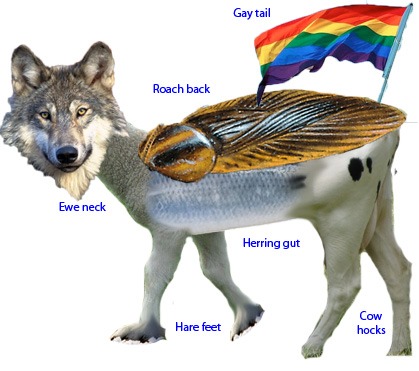
Conformation chimaera
A breed standard describes what the breed should ideally look like. Click to see the US breed standard with illustrations. Just as no poodle has a perfect temperament, there is not a poodle alive who is the living, breathing incarnation of the breed standard. If you want a poodle to do dog sports or work with, some faults are however more serious than others. Faults with the head shape, ears, and expression should be considered minor, unless they obviously impact on the dog's wellbeing such as in the case of a poor bite or constantly dribbling eyes. The most important conformation aspects are the angulation, balance, and general body proportions. The shoulder layback and return of upper arm should be balanced, and the front angulation should balance with the rear. There should be adequate bone, chest depth, and spring of rib, and the dog should ideally be short in the loin. A standard poodle is defined as being any height over 15", but be aware that the usual height is around 20"-25". While some poodles do grow to 26" or over, this is not ideal for most activities one might want to do with a working dog.
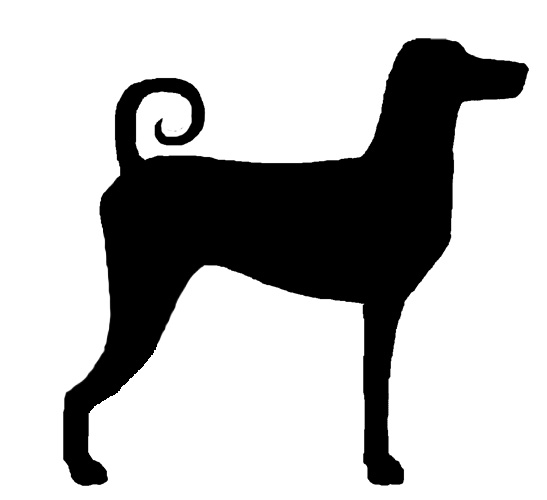
This bitch has a gay tail that is set lower than ideal. She could do with a bit more reach of neck and her head is possibly also a bit heavier than preferred. However, she has good, balanced angulation and her faults should be considered minor as they should have no real impediment upon her working function.
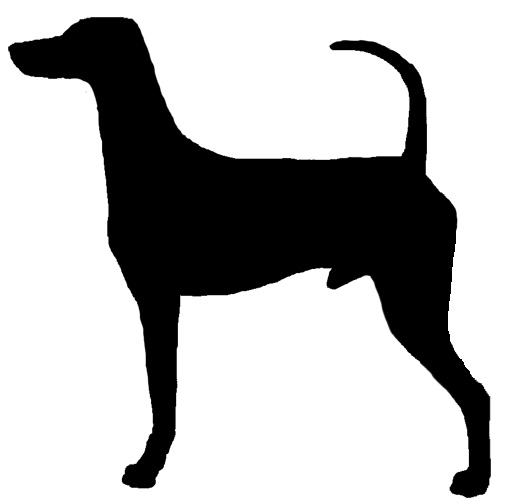
This dog is a bit lacking in substance and could do with more angulation. However, his angulation is balanced and he is still functional. Particularly if the dog is to be doing work where a lot of sharp turning is involved, a slightly lower hock might be preferable to give more stability.
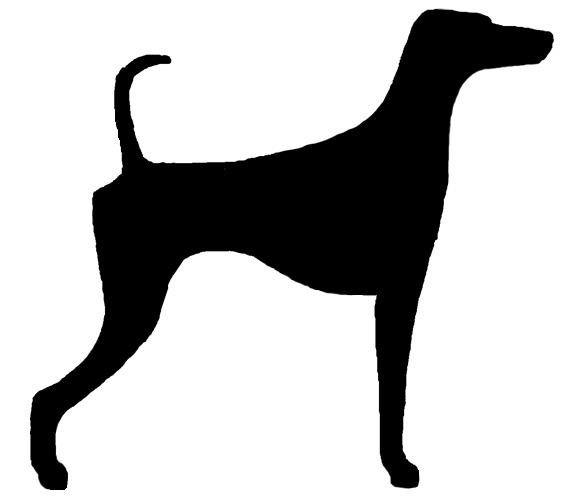
This bitch has some severe faults with her conformation. She is extremely unbalanced, with very little angulation in the front and too much in the rear. This imbalance causes her topline to slope downwards from withers to croup, and in show coat will give the illusion of a long neck. She also has a herring gut coupled with short brisket and very long loin. These faults will make it more difficult for her to excel in physical dog sports. It should also be noted that while poodles should not have enormous flat feet, they are meant to be water dogs, and very tight, small feet like on this bitch are not efficient for a swimming dog. Her very shallow pelvis is also not correct, and many who work with poodles prefer a slightly steeper pelvis than the one in the breed standard illustration.
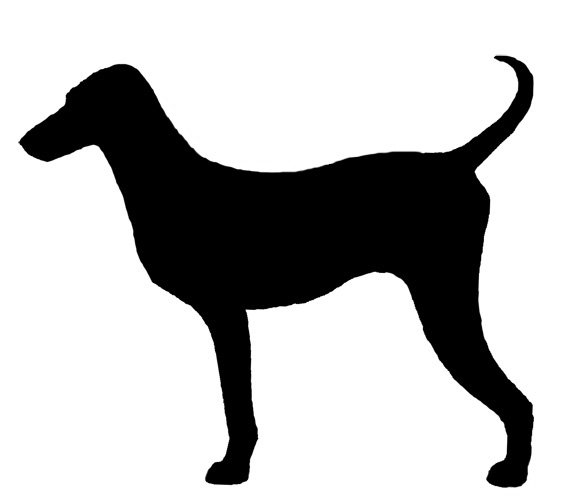
This bitch's low tail carriage is a fairly superficial fault that will have little impact on her ability. However, her unbalanced front is a more serious fault. She has too much return of upper arm and not enough shoulder layback -- her front assembly appears to be rotated counterclockwise. This makes it difficult for her to raise her head fully and causes a weak topline that slopes upwards from the withers.
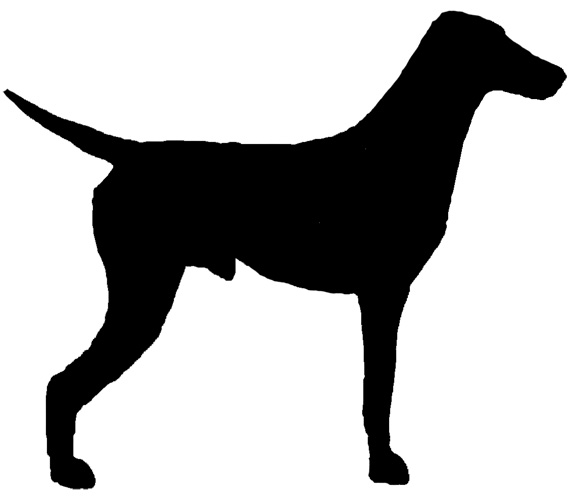
This dog's carriage is sloppy. His tail and head do not go up as high as in the standard. The low tail carriage is of little consequence. Low head carriage can sometimes cause problems when doing a sport in which the dog has to look up high, such as the scale in working trials. As in the previous example, sometimes poor head carriage can be caused by a fault with the front assembly, and in other dogs there is no underlying issue and the neck it seems is just not as flexible as it might be. Be aware that most dogs will not naturally stand with their heads held as high as in the diagrams in the breed standard, but a properly put-together dog should ideally be able to raise its head to this position or close to it if its head is (non-forcibly) held, or it is led up into that position with a treat. The neck should not be completely vertical nor tilted backwards.
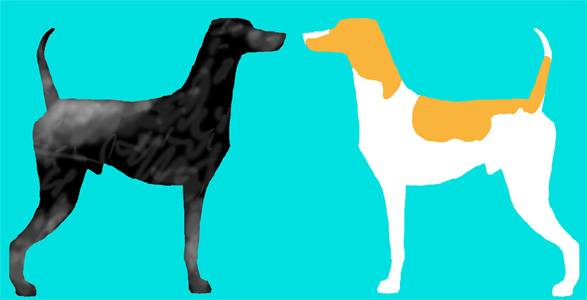
These are examples of superficial faults that have no effect on a poodle's working ability. The dog on the left is a black that has grizzled and gone a mucky uneven colour. The one on the right has a 'spotting' colour fault caused by a recessive gene. Other examples of colour faults include being cream or white with brown nose and eye pigment, being marked like a Rottweiler, and various other 'agouti' patterns that cause puppies to be born with odd patterns which generally fade at maturity to even or uneven dull shades. None of these faults have any bearing on a dog's athleticism or ability, although light-coloured and parti-coloured dogs may be disliked by hunters and outdoorsmen because of their poor camouflage qualities and the ease with which they become dirty.
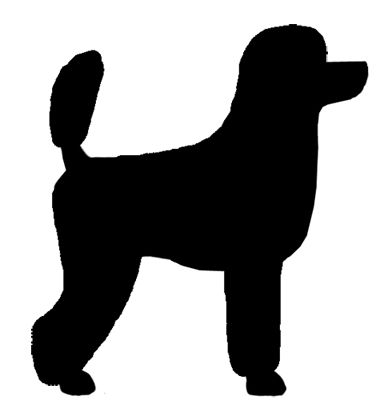
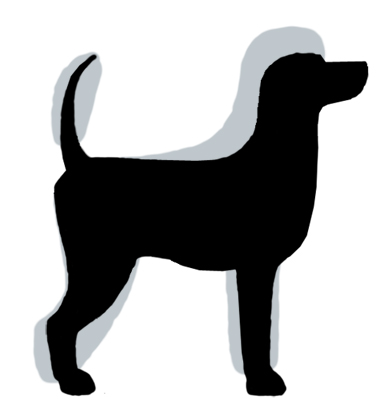
A puppy who will grow into a poodle with ideal structure will probably look something like this. The effect of a fluffy puppy coat, with the shape of the puppy illustrated underneath, is shown in the above images.
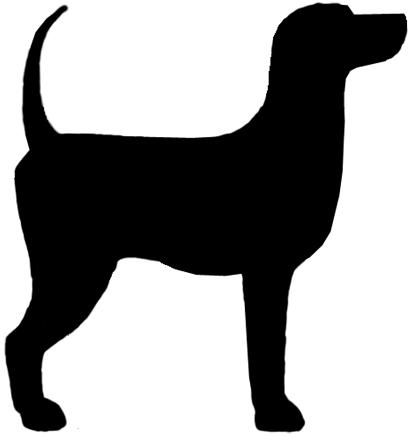
Thoughts on looking for a functional poodle
While a dog with a good attitude and an interest in working or sports will certainly go a long way towards making up for any of its conformational shortcomings, having a dog with seriously poor structure is probably just as difficult as having a hard to motivate dog with no interest in what it is supposed to be doing, with the only difference being that the poorly conformed dog with a good attitude is rewarding at first but becomes impossible to make progress with at higher levels. Training and good socialisation will also help even out extreme temperaments, but a dog that doesn't like strangers will never be the best therapy dog, and a dog that just isn't interested in toys will never enjoy retrieving for its own sake. When looking for a puppy:
Ask the breeder for their honest opinion of the parents on the eight temperament categories. And if you are the breeder, be honest and objective, as you should be with conformation evaluation, since not doing so will only hold back your breeding programme from the objectives you want to achieve.
Look at the temperaments and structure of the puppies. Puppies change as they mature and many things cannot be predicted, but it should be possible to have a go at judgement about angulation and balance by 8 weeks.
Remember that no dog is perfect either in temperament or conformation. However, if you feel all the available pups have too many faults in both, the breeder should respect your decision to wait for another litter or look elsewhere.
Remember that many aspects of temperament may be compromises or even mutually exclusive. Highly people-oriented dogs are very often jealous and not particularly good at getting on in a house with other dogs. Highly driven dogs are a nightmare to live with if they don't have enough work to keep them occupied.
If this will be your first dog, and you have the idea that you want to have a go at something like agility or working trials, the driviest dog you can get your hands on is likely to be too much to handle. Choose a nice-natured dog with more classically 'pet' attributes and reasonable basic structure. This dog will teach you a lot, and if you do enjoy your sport a lot, you can later get a more drivey dog when you have more experience and transfer what you have learnt to it.
For agility, do not choose an obviously large puppy. Poodles for agility should really mature 24" and under -- the physical stress of the turning and manoeuvring is too much for a larger, heavier body, and remember that a good front assembly will make a dog shorter at the withers than it otherwise would be, and a properly put together 24" dog is a lot bigger and more substantial than a dog with an upright front of the same height. Being bigger is not a disadvantage for working trials, however.
A dog who isn't into strangers or other dogs should not really be a problem if you want to do agility. Working trials dogs should like toys and be confident around strangers.
The most important aspect of a dog for therapy work is that it likes strangers. Conformation is unimportant in this case.